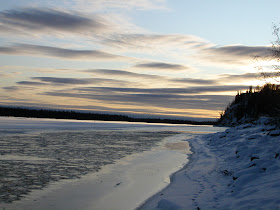Pages
▼
Monday, August 22, 2011
Setting CPR
The Tanana River carves its way through birch forests and black spruce swamps. By Alaska standards it’s a pretty ordinary river: silty and swift, braided but no white-water, and glacial in its origins.
I float parts of the Tanana every summer.
A couple summers ago it was over eighty degrees and we had a tail wind for two days. But sometimes the wind blows so hard that you find yourself in a dust storm and five foot standing waves. One year I had a bad headache and what was usually enjoyable
was tortuous.
Sometimes we find surprises, like the entrance to a wolf den.
And that’s just summer. Here’s what the Tanana looks like in late fall.
Several years ago three of my former students stole a canoe and took off down the Tanana. Maybe to have a Huck Finn adventure, I’m not sure. They swamped their canoe and ended up on a remote island in the middle of the river. Cold and soaked and with no supplies. Luckily a helicopter plucked them from the island after a couple of cold nights.
Take a look at the setting (or settings) in your story. Are you utilizing your setting to its potential? Look at it from odd angles and different seasons. Through different eyes.
Here’s some questions I ask myself when I’m doing CPR on my setting:
How do the setting details I choose to include drive the story forward?
How do they develop character?
But most important, consider the emotional state of your POV character. Let that emotion infuse and drive setting details whether your character is in a padded room or on top of a mountain. Otherwise, that description might stop your story dead in its tracks.
I think that setting, if properly developed, can turn a good story into a great one.
And, a little bit of writing-news: My MG novel, Stranded, was awarded second place in the Pacific Northwest Writers Association's Annual Contest.
I'll be teaching school all day today but I'll check back in the evening to see what's happening.
Thanks for stopping by.






Congrats on the second place award! That's great :D
ReplyDeleteI'm always looking for ways to help my setting, because that's that hardest part of writing for me. I have floating head syndrome.
Paul,
ReplyDeleteEven though the kids shouldn't have taken the canoe, I have to say I'm glad to hear kids still do crazy things to have adventures. Actually, I'm happy other people's children do crazy things.
But back to the point of your post. I love settings if they are outside my ordinary world. Part of the reason I like to read is to explore other places in my own head.
Congrats on Stranded! I'd like to read that (seriously).
Those are gorgeous pictures, Paul! Sometimes when I'm stuck on setting, I look through photography books to inspire my imagination.
ReplyDeleteCONGRATS on the award! That's great news!
Paul, oh my gosh! Congrats on the award! I'm so happy for you! That is awesome!
ReplyDeleteHilary, Marissa, Dee, and Rebecca, Thank you!!
ReplyDeleteCongratulations on Stranded, Paul! Wonderful news, indeed.
ReplyDeleteSettings often make a story for me--I love being sucked into a scene by a vivid description or wonderful imagery.
Congratulations, Paul! I love it when the setting for a story is so vivid it almost takes on a life of its own, becoming like another character.
ReplyDeletePaul, as always, you make me jealous of your adventurous life and the beautiful scenery you've been able to gaze upon through lenses you don't have to hold. Setting, for me, is crucial. In every MS I've written, I've treated setting as if it's a character in itself. When your characters interact with the setting, seeing how they react to the setting or how it reacts to them is, in itself, characterization. I think of CHARLIE AND THE CHOCOLATE FACTORY as a prime example of this type of reactionary characterization of setting. And I think it's paramount in a great story. Oh, and congrats on the award. I'd love to read STRANDED sometime.
ReplyDeleteGorgeous photos, Paul! Great post.
ReplyDelete